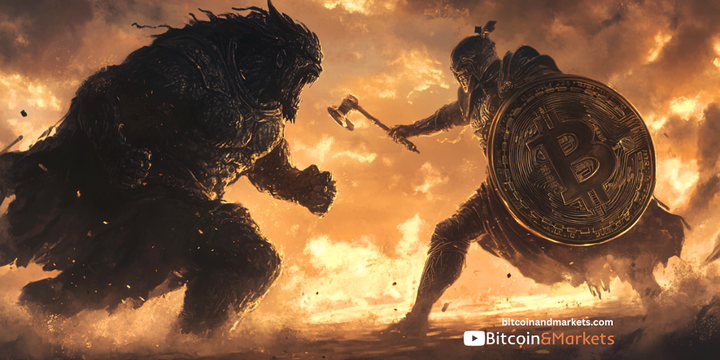Bitcoin Fundamentals Report #171
This week... record CPI inflation, regulating stablecoins like banks, price analysis, mining headlines and spiking hash rate, and Ethereum fees.
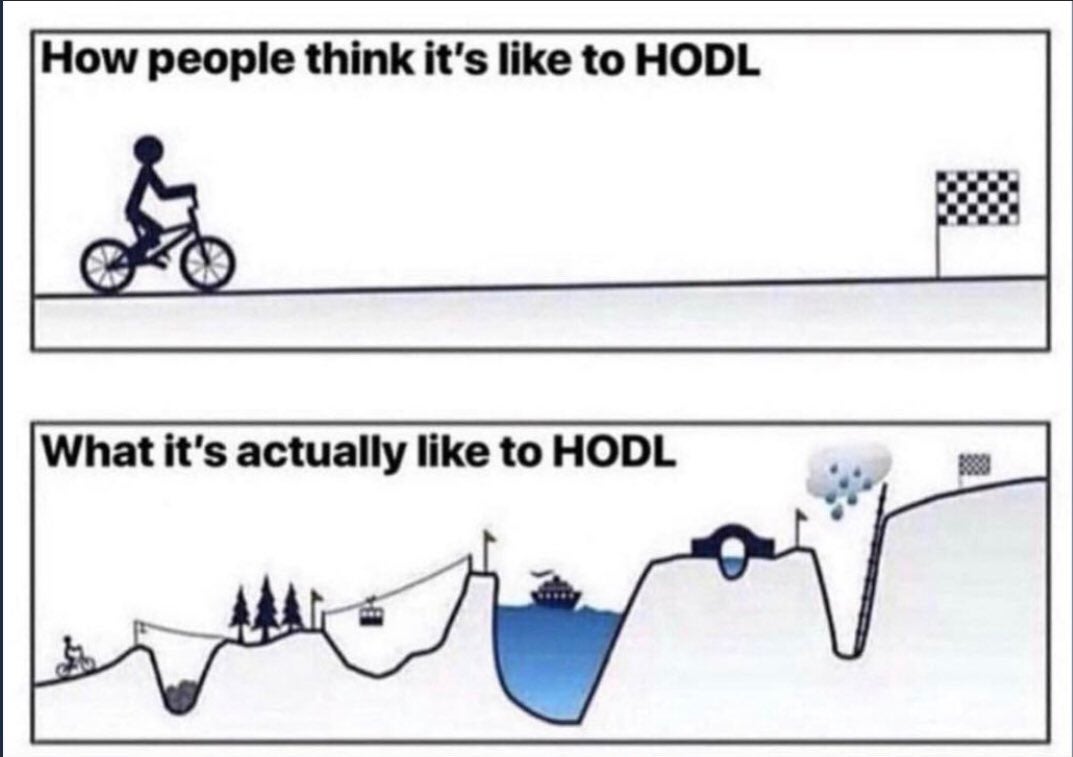

A weekly newsletter summarizing important sectors in bitcoin
by Ansel Lindner
This week... record CPI inflation, regulating stablecoins like banks, price analysis, mining headlines and spiking hash rate, and Ethereum fees.
In Case You Missed It...
- (Podcast) Powell Retires “Transitory”, IMF Warns of Collapse - FED 73
- (Livestream) We are now livestreaming Fed Watch on Tuesdays at ~2pm EST as part of Bitcoin Magazine's new livestream.
- (Blog) Macro Chart Rundown - 6 Dec 2021
- (Op-Ed) Understanding the Interest Rate Fallacy: The Risk of Holding Fiat
Visiting the content on other sites helps tremendously, like bitcoinmagazine.com and YouTube! The best way to support is by sharing to family, friends and social media groups, or becoming a paid member!! Thank you for reading.
Get the Bitcoin Dictionary now on Amazon!
Market Commentary
| Weekly trend | Scary consolidation |
| Media sentiment | Negative |
| Network traffic | Low |
| Mining industry | Hash rate surge to ATH |
| Market cycle timing | Later consolidation before repricing |
Hello dear reader,
Once again, the bitcoin news cycle has been slow this week, dominated by the price declines. I'll admit, the rollercoaster is never fun, but it does become easier the longer you've been in the space. The market will take the path to its destination that is the most challenging for people to make and keep their gains.
Some people get the wrong idea, they think bitcoiners hit the lottery and got lucky. Real holders of bitcoin, the true believers that stand the test of time, have never touched their stash of coins. They've perhaps spent a little here and there, but they realize that it is not the destination but the journey. That is the sentiment you must have to approach this market successfully.
I recently had a discussion with CK on Fed Watch about a new dynamic for the cycles. I have said for a while now, that gains in bitcoin will be confined to shorter periods of time. Gone are the days of the smooth 2 year parabola. In other words, we will have long periods of consolidation, and fast repricing events to a higher level. (Thanks to CK for those words, we agreed, and he had the better words for it) Check out the Price section below for more.
I have been buying this dip, but you can tell the market is depressed. There is a general anxiety out there. It's okay, that's when the market is about to bottom.
Let's dive in to this week's general news.
CPI Inflation
Today, the BLS released the US CPI numbers for November and the headline number was pretty big, 6.8% YoY (year-over-year) inflation. That "YoY" matters because it was 0.8% MoM (month-over-month). That is down from last month's 0.9%, and there were some other interesting data in the report.
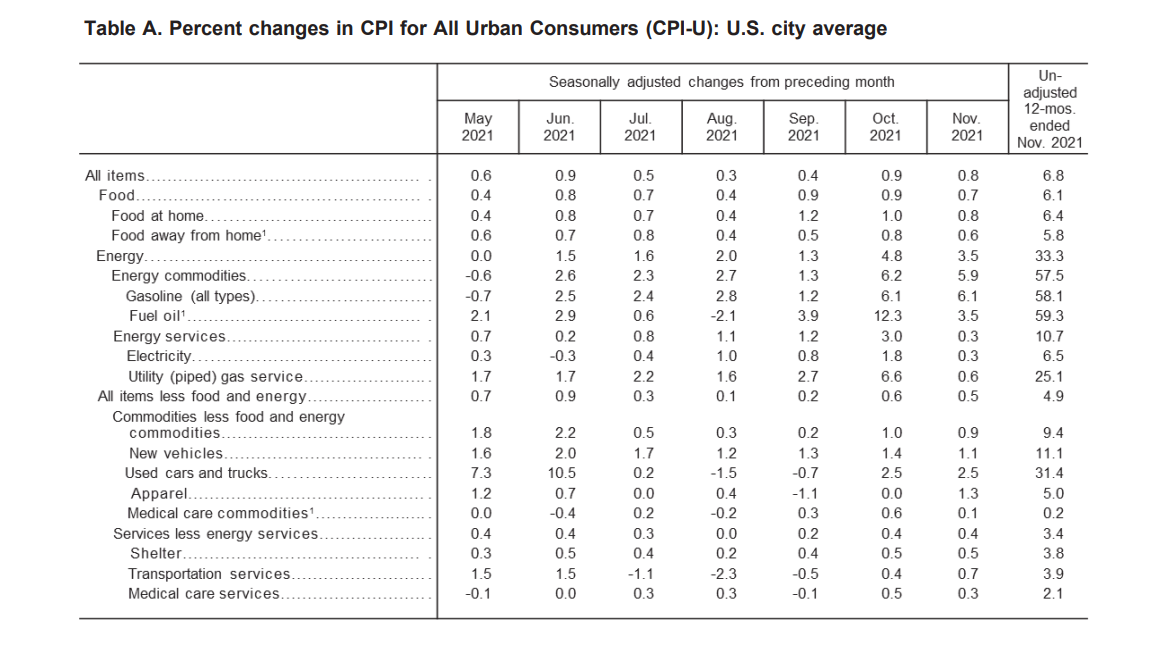
If you take a look at the differences between Oct and Nov, what is striking is that it is a broad-based decline. Only two items accelerated, apparel and transportation services.
To me, this is a report showing slowing inflation, and that is what the MoM number tells us.
Related to CPI inflation is wages. Some people are worried about runaway inflation. For that to occur, wages need to keep pace. In fact, I'd argue that wages need to lead prices higher. So, what's up with wages in the US?
Below, we see wages through Oct 2021, "Overall" wage growth is flat at about 3.5%. It is even lower for the top two quartiles, where much of the dynamism and growth starts from. You can't support 6% inflation with 3.5% wage growth. Just ain't gonna happen.
Typically, we'd like to see wage growth slightly higher than inflation. For argument sake, if wages keep growing at 3.5%, it could support something around a 2% inflation rate. If that wage growth shrinks, which I think it will, to say 2%, it can only support 1% CPI growth.
What happens if wages can't support inflation? Recession. Higher prices will be rejected by the market.

Japan wants to treat Stablecoins as banks
One of the things the bitcoin industry is waiting for is regulatory clarity on stablecoins. Chairman Powell of the US Fed has eluded to regulating them as banks and now Japan wants to do the same thing.
This would mean that companies such as Tether wouldn’t be able to issue stablecoins to Japanese companies and users unless they were registered as banks or wire transfer providers.
Opening up banks to stablecoins and bitcoin is very high on the To Do list for bitcoin to become a major currency. Each month we see development in that direction.
SHARE our content with friends and family!
Quick Price Analysis
| Weekly price* | $48,274 (-$4,526, -8.6%) |
| Market cap | $0.911 trillion |
| Satoshis/$1 USD | 2,072 |
| 1 finney (1/10,000 btc) | $4.82 |
Become a paid member to access our much more in depth technical analysis on the member newsletter.
Bitcoin Daily Chart
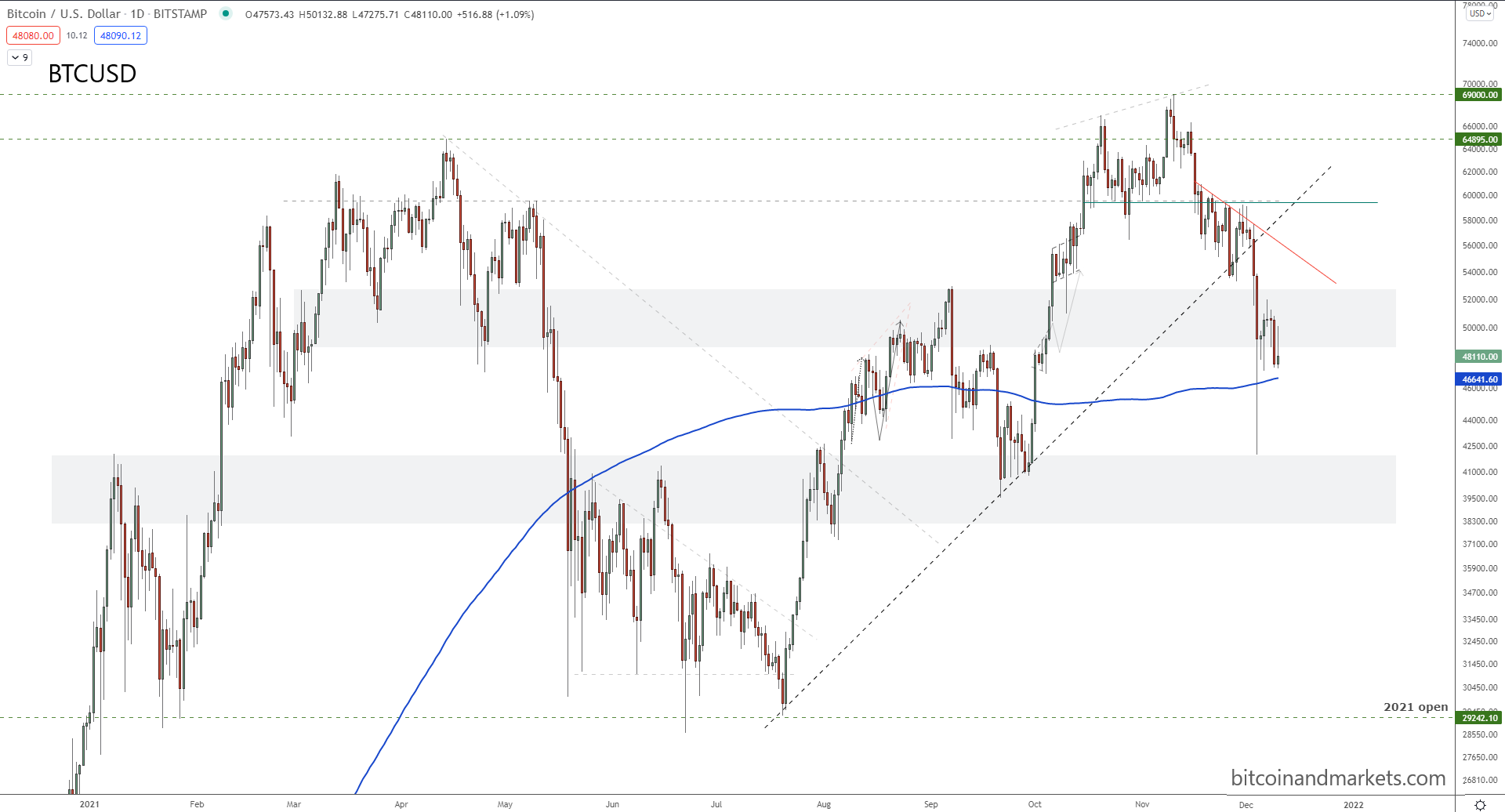
What a dip. Big flash crash, followed by a nice bounce, but the bounce has not lasted.
As impressive as the crash was, it still did not push the daily into oversold territory. That's worrisome for the near future, because price could return to the low in order to reset daily indicators.
Currently, price is resting on the 200 daily MA, a very important level for bitcoin, being source for the bitcoin-famous Mayer Multiple. If price can bounce here, it would need to get back up to $55k to be out of the woods. That is a tall order on a quiet news week and an altcoin sector that is prime for the popping.
The most likely scenario is sideway to down for the next week. Altcoins will fall more than bitcoin, as we are already seeing in ethereum, down 5% against bitcoin in the last two days.
Bitcoin Cycles and Repricing Events
The destination is at least gold's market cap of $8-10 trillion. At $1 trillion now, that means the bitcoin price will need to add a zero. And that's the low mark, if it is to become a major global currency, which I think it will in the next decade, its market cap will need to approach $50-$100 trillion.
The below chart is showing possible repricing cycles. During the flat periods, people become uncertain and bearish narratives will take hold. Then the price will shoot upward to a new price level. This is different than the 2016-2017 bubble, but kind of similar to the 2013 market.
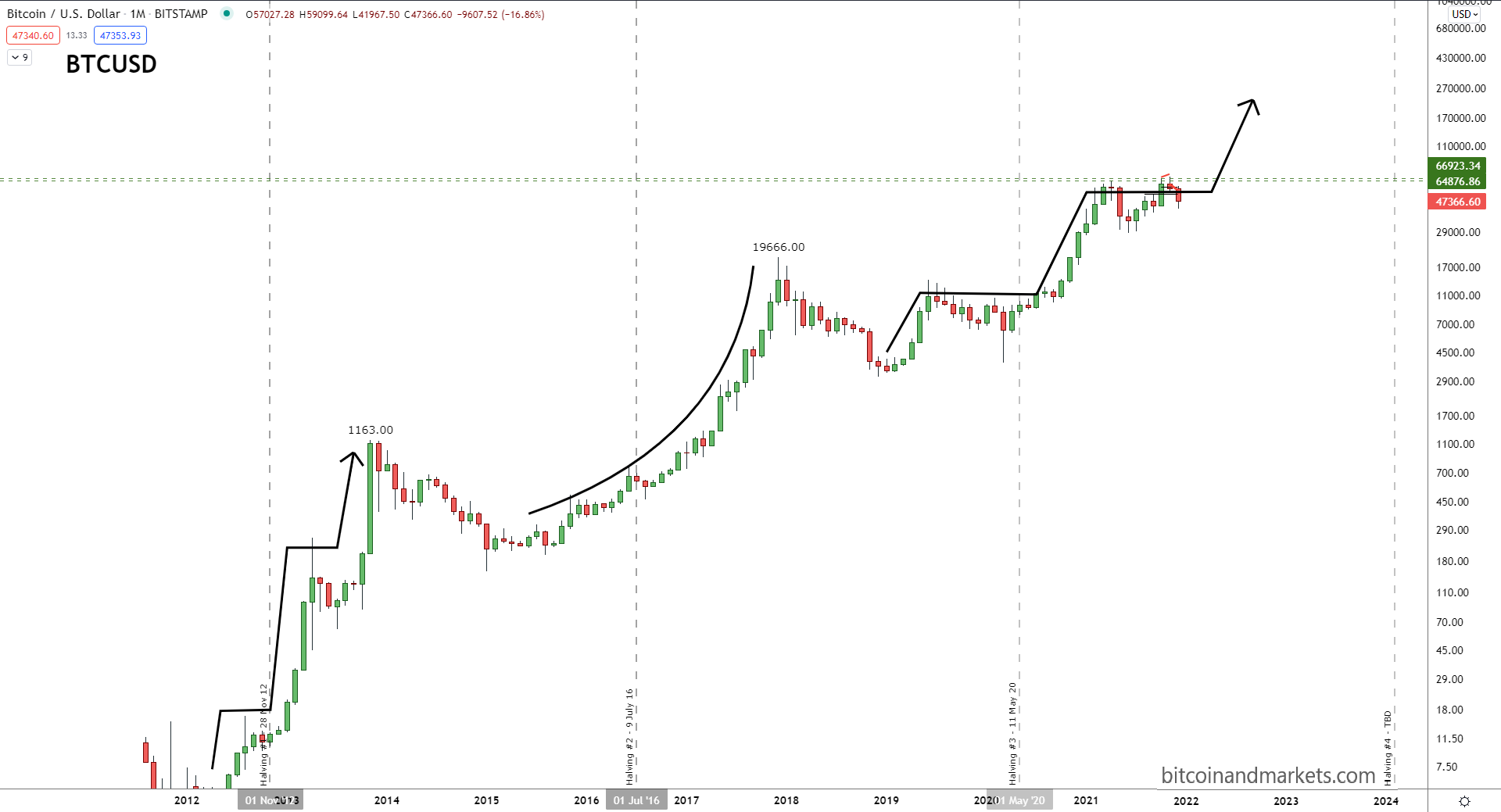
Taking out the Corona Crash
Another way to look at this is, that the price will fluctuate around a trend. I've placed an arrow on the chart that splits the difference. The high points get overbought, and the low points are oversold.
Zeroing in on the corona crash in March 2020. Price wanted to go higher, but the liquidation event was just too intense. It took several months, but the reaction to that dramatic of a liquidation resulted in the late 2020 rally all the way up to $64k. If the corona crash would not have happened, we might have seen something very similar to what we are seeing today. Minus another massive crisis then, price should tend to stick closer to the line than last time around.
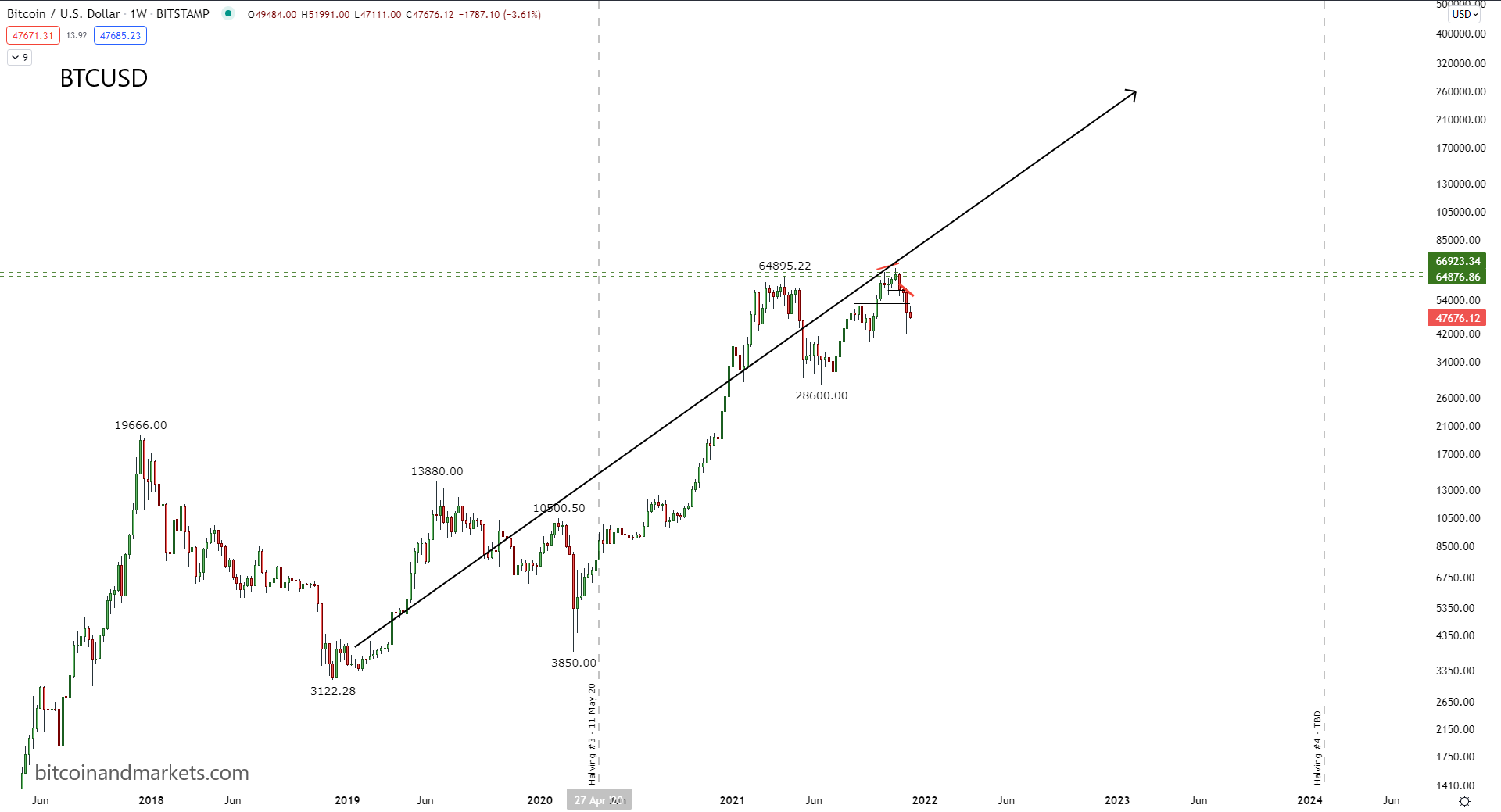
Below, I just take the present price action in the box and stuck it back onto the corona crash. You can see, the recent rally to new ATHs, and subsequent drop, has put us back into line with the previous era. I expect price to get back toward this line, and could hit $100k by March.
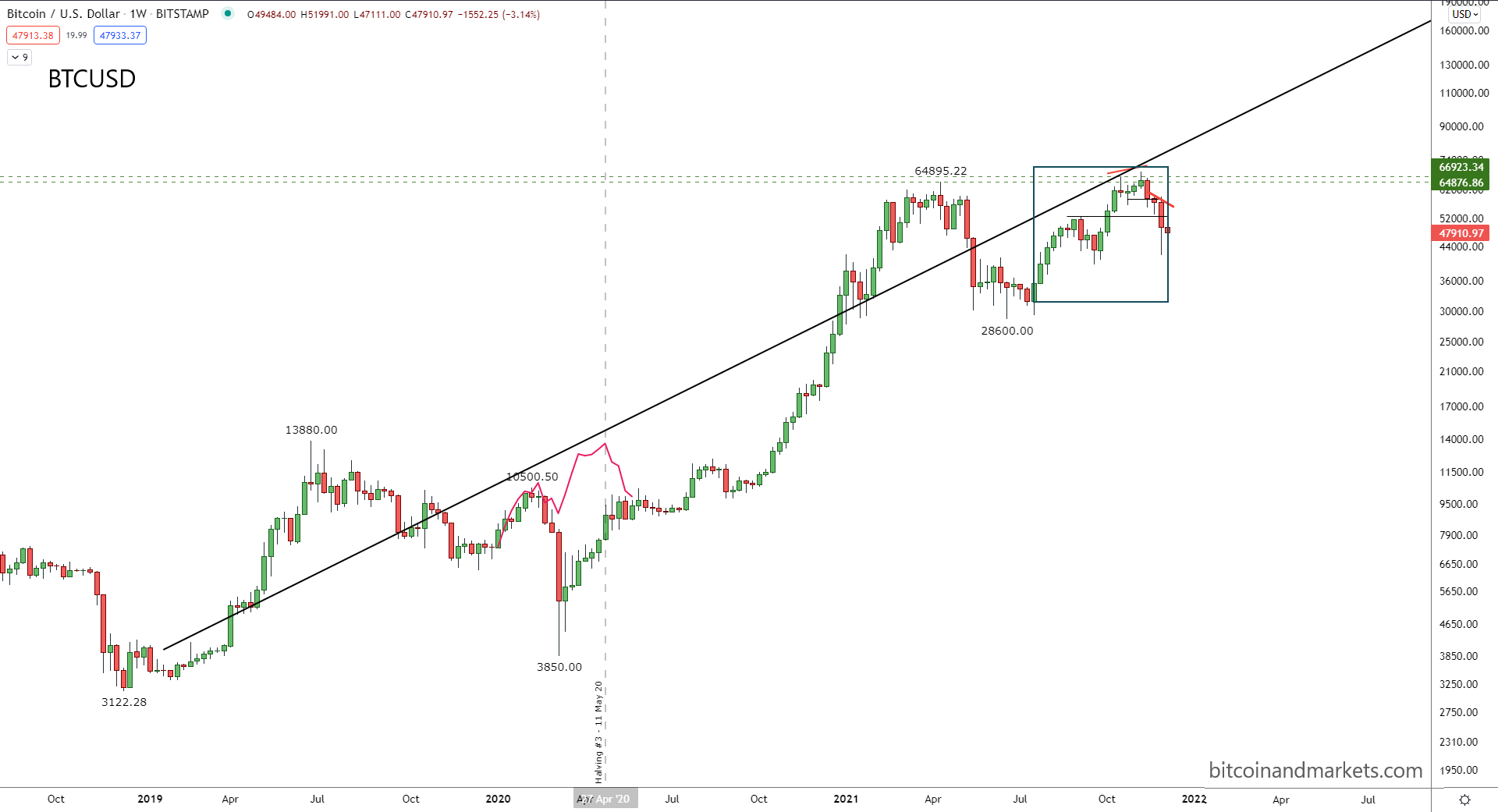
Get more price analysis, Sign up for the Bitcoin Pulse!
Mining and Development
| Previous difficulty adjustment | -1.49% |
| Next estimated adjustment | +7.8% in ~0.5 days |
| Mempool | 3 MB |
| Fees for next block (sats/byte) | $0.61 (9 s/b) |
| Median fee (finneys) | $0.07 (0.015) |
Mining News
'Mecca of mining': Brazil considers zero tax on green bitcoin mining
Kazakhstan places limits on bitcoin mining power use
Bitcoin miners say they’re helping to fix the broken Texas electric grid — and Ted Cruz agrees
Hash Rate and Difficulty
Hash rate spiked this week getting very near to an ATH. Hash rate is not a perfect science, it is calculated from the speed of blocks coming over a certain period of time. Depending on the period of time used, some websites will differ slightly. As of now there is not a new ATH for hash rate but it is very close.
Back in July this year after the Chinese miners were forcibly turned off, I said it was likely the hash rate would fully recover by the end of the year, and that has now come true.
What does this say about price? Not a whole lot, but it does say that from the miners' perspective, they do not see any systemic issue with the network or their wholesale side of the house. Miners tend to sell OTC to big buyers or lend out their bitcoin. So, they represent a different type of market participant as compared to ETFs, hedge funds, and retail traders.
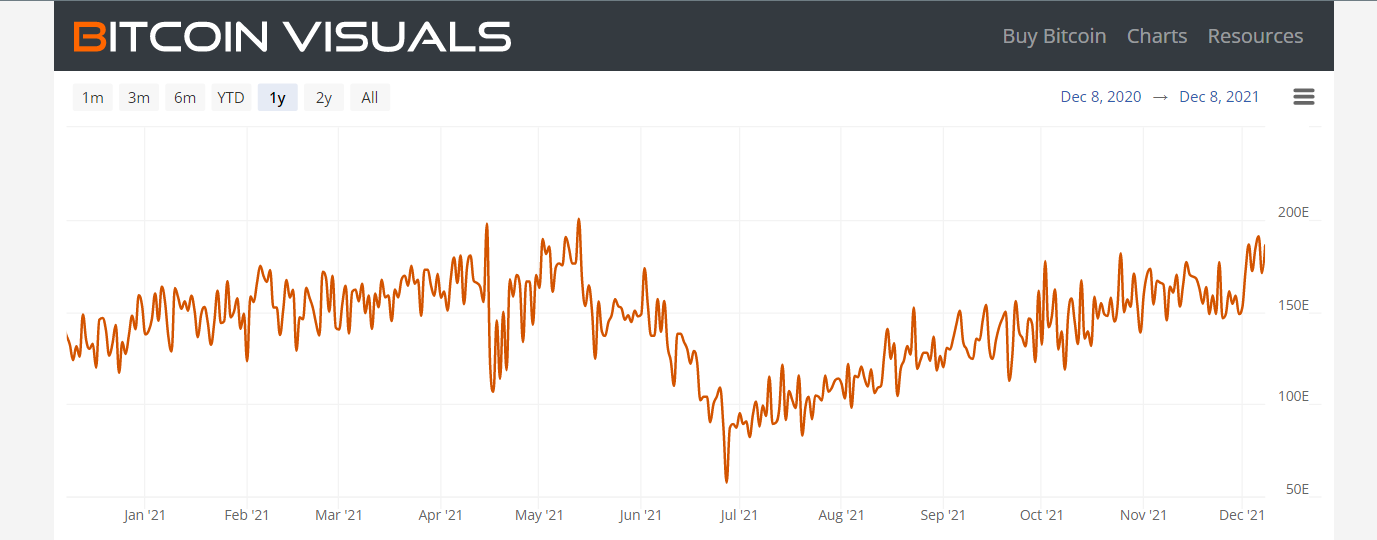
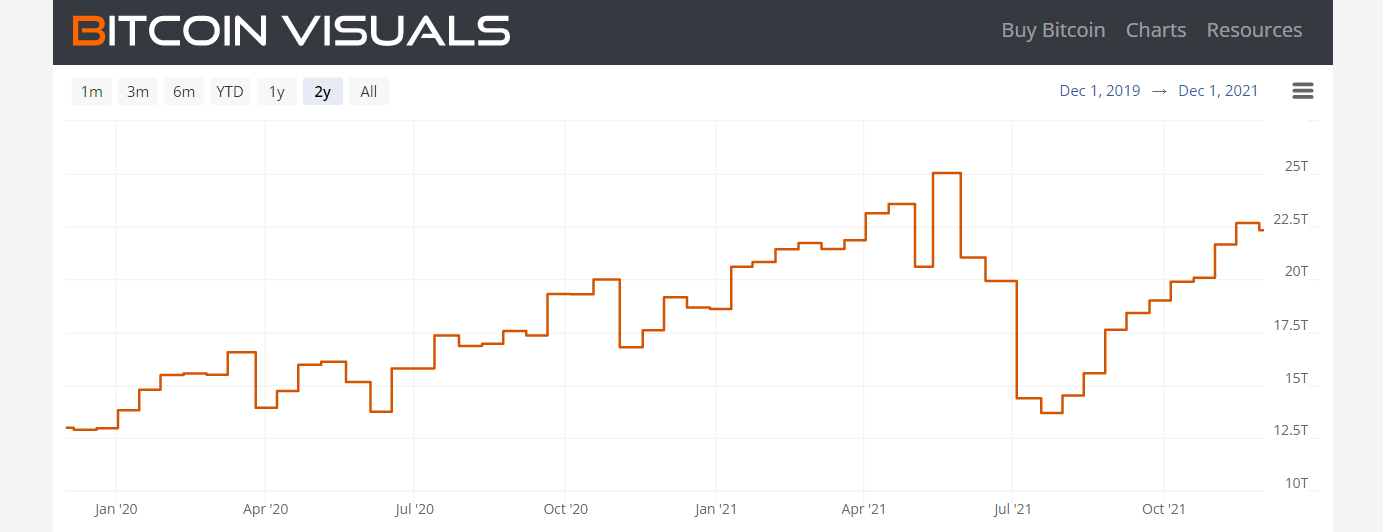
Altcoins / CBDCs
Ethereum Fees are Out of Control
I tend to avoid most of the discussions around altcoins, because I view them as Ponzi schemes. But once a week or so, some debate or news item catches my eye. This week it is the rising fees on Ethereum.
Ethereum fees are often broaching the $100 mark for simple transactions, like sending your NFT somewhere, or loading a wallet with a stablecoin. For instance, in you want to send $50 USDC to your wallet, it can cost upward of $150 in fees.
A recent post on Decrypt.co took a look at this situation and the cannibalistic competition the fees are producing from other networks like Solana and Avalanche. Of course, these new low cost options will face the same problems as ethereum if they grow to similar size.
However, when these altcoin believers discuss the problem, they get simple things wrong, the fundamentals of the issue, go figure:
These kinds of networks are essentially fee markets, in which transactions compete for block space to be processed. As that block space fills up due to an increase in activity, this market becomes all the more competitive.
Transactions on ethereum do complete for block space, but only after they compete for execution time on nodes. See, ethereum-type networks attempt to decentralize computation to each and every node, where bitcoin decentralizes validation. There's a big difference. Complex smart contracts take significant time for the node to calculate and update their records. Bitcoin transactions however, take no significant time at all to validate. It is a simple hash for bitcoin.
That is a fundamental reason why "smart contract platforms" like ethereum will never scale. For ethereum to maintain any substantial level of throughput it will become extremely expensive to run a node, because the burden of decentralized computation.
That's the whole idea behind ETH2.0. They are trying to create many individual networks (shards) with their own transactions and nodes, then stitch them together into an overall block chain they call the beacon chain. Of course, this solution is very dubious, because as you add shards maintaining distributed agreement amongst nodes (consensus) without a trusted third-party become nearly impossible. Even if they achieve this technical feat initially, it will always be extremely fragile. Unlike bitcoin, which gets strong with time.
Anyway, no matter how you slice it, more activity inevitably begets higher prices.
Ha! That is definitely not the case here. What kind of activity are you talking about? There is such thing as "spam", transactions that flood the network to clog it up. There can also be other malicious actors that exploit the complexity (hacking). It's like you have a shelf that can hold 50 lbs and you through 100 lbs on it. What do you think will happen? More activity on a fragile system increases risk, and price will not necessarily rise.
Lastly, Eth fees are so high, everyday use of the ethereum network is out of the question. So, why are NFT prices and the Eth price so high? Because it's a Ponzi. People are not using it for competitive and productive use cases that will change the world. It is frantic speculation. The killer app of ethereum is layering Ponzi schemes.
Get our book the Bitcoin Dictionary now on Amazon!
- Were you forwarded this newsletter? You can subscribe here.
- Podcast links and socials on our Info Page.
- If you liked this newsletter please SHARE with others who might like it!

December 10, 2021 | Issue #171 | Block 713,573 | Disclaimer
Meme by: unknown
* Price change since last week's issue




